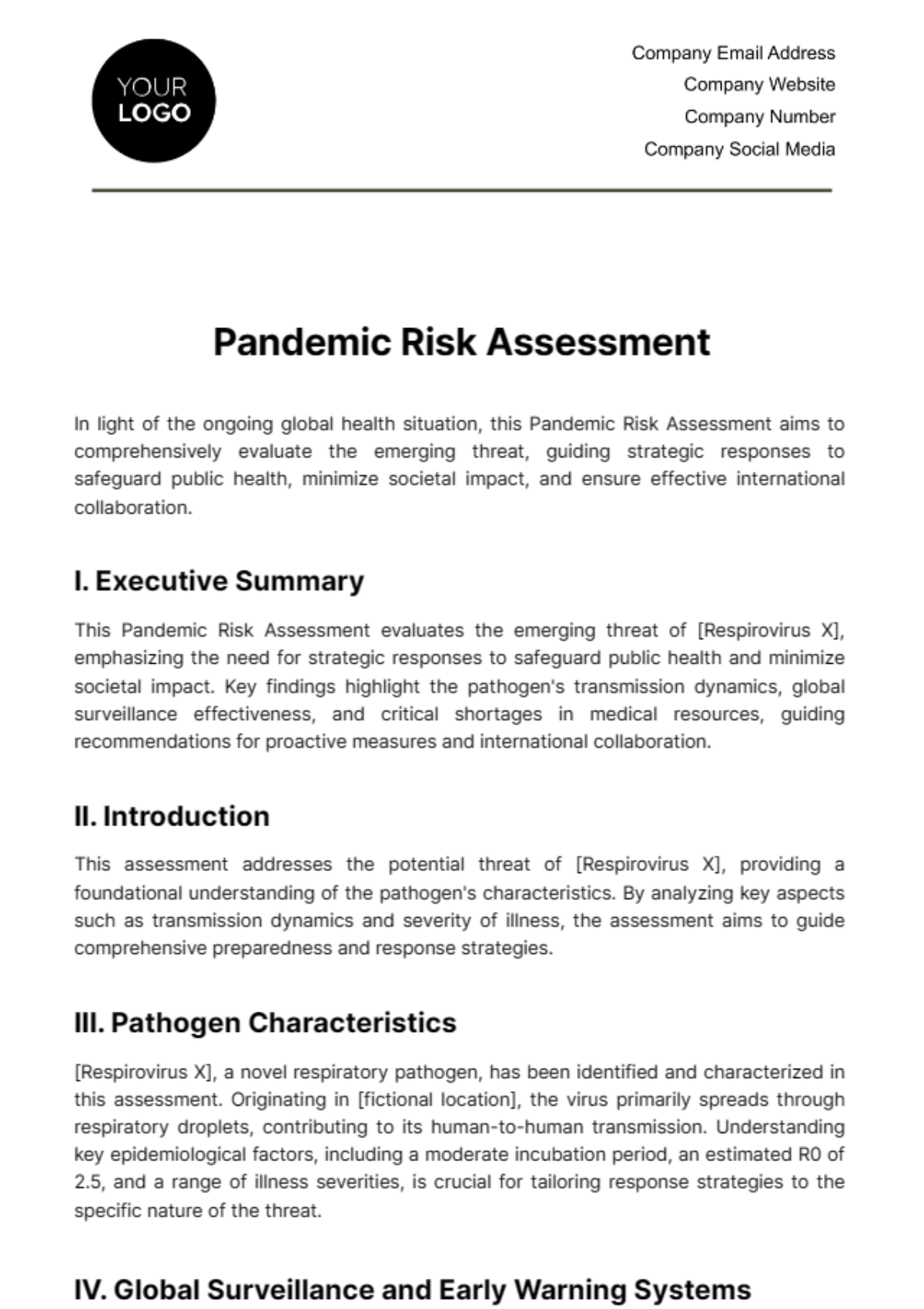Free Pandemic Risk Assessment

In light of the ongoing global health situation, this Pandemic Risk Assessment aims to comprehensively evaluate the emerging threat, guiding strategic responses to safeguard public health, minimize societal impact, and ensure effective international collaboration.
I. Executive Summary
This Pandemic Risk Assessment evaluates the emerging threat of [Respirovirus X], emphasizing the need for strategic responses to safeguard public health and minimize societal impact. Key findings highlight the pathogen's transmission dynamics, global surveillance effectiveness, and critical shortages in medical resources, guiding recommendations for proactive measures and international collaboration.
II. Introduction
This assessment addresses the potential threat of [Respirovirus X], providing a foundational understanding of the pathogen's characteristics. By analyzing key aspects such as transmission dynamics and severity of illness, the assessment aims to guide comprehensive preparedness and response strategies.
III. Pathogen Characteristics
[Respirovirus X], a novel respiratory pathogen, has been identified and characterized in this assessment. Originating in [fictional location], the virus primarily spreads through respiratory droplets, contributing to its human-to-human transmission. Understanding key epidemiological factors, including a moderate incubation period, an estimated R0 of 2.5, and a range of illness severities, is crucial for tailoring response strategies to the specific nature of the threat.
IV. Global Surveillance and Early Warning Systems
Our assessment reveals that current global surveillance systems have shown efficacy in detecting and monitoring potential pandemic threats. However, disparities exist in regional capabilities, necessitating targeted improvements. Strengthening early warning systems will be essential to enhancing global preparedness. Recommendations include collaborative efforts to bridge regional gaps, share best practices, and invest in technological advancements that can bolster surveillance effectiveness.
V. Healthcare System Capacity
The evaluation of healthcare system capacity emphasizes both infrastructure and workforce preparedness. While critical resources such as ventilators are available, shortages in personal protective equipment (PPE) raise concerns. Training programs for healthcare professionals are ongoing, with clear surge staffing strategies in place. Protecting the healthcare workforce is prioritized through established protocols. Recommendations focus on addressing shortages and ensuring comprehensive training to fortify the healthcare system's capacity.
VI. Public Health Interventions
This section outlines a two-pronged approach, emphasizing vaccination and non-pharmaceutical interventions. Plans for vaccine development and distribution campaigns are established, alongside considerations for potential challenges. Non-pharmaceutical interventions encompass social distancing measures, travel restrictions, and communication strategies. Clear communication with the public is deemed crucial, emphasizing adherence to recommended interventions for effective pandemic mitigation.
VII. Socio Economic Impact
Our assessment delves into the anticipated economic and social consequences, addressing disruptions in industries, supply chains, and vulnerable populations. Economic support measures are under consideration to mitigate industry-specific impacts. Strategies for maintaining essential goods and services within disrupted supply chains are emphasized. Social consequences, including mental health challenges and disruptions in education, necessitate targeted interventions to minimize societal impact.
VIII. Vulnerability and Resilience of Communities:
Identifying vulnerable populations and ensuring healthcare accessibility are pivotal components of community-focused strategies. Strengthening community resilience and support networks is emphasized, with targeted efforts to address disparities in access to healthcare services. By focusing on the vulnerability and resilience of communities, the assessment aims to develop tailored interventions that address specific needs and challenges.
IX. International Collaboration and Coordination:
Recognizing the global nature of the threat, the assessment underscores the importance of international collaboration and coordination. Active engagement with organizations such as the WHO is highlighted, with mechanisms in place for information-sharing and resource mobilization. Collaborative responses and mutual support among neighboring countries are prioritized to create a unified front against the potential pandemic.
X. Monitoring and Evaluation:
The establishment of monitoring mechanisms and key performance indicators ensures ongoing evaluation and adjustment of response strategies. Surveillance systems are designed to track the progression of [Respirovirus X], enabling timely interventions. Regular evaluations of the risk assessment, incorporating emerging information and trends, are fundamental to maintaining adaptability and responsiveness.
XI. Recommendations and Action Plan:
Based on the assessment findings, prioritized recommendations are presented with an accompanying action plan. Immediate actions include strengthening surveillance, securing PPE, and accelerating vaccine distribution plans. The action plan outlines specific steps, responsibilities, and timelines to guide the implementation of recommendations, ensuring a proactive and coordinated response to the emerging threat.
XII. Conclusion
This Pandemic Risk Assessment provides actionable insights for safeguarding public health, minimizing societal impact, and fostering effective international collaboration. The multifaceted approach addresses pathogen characteristics, healthcare system capacity, public health interventions, socioeconomic impact, community vulnerability, and international coordination. Continued collaboration, vigilance, and swift implementation of response strategies are emphasized as essential elements for navigating the potential challenges posed by [Respirovirus X].
- 100% Customizable, free editor
- Access 1 Million+ Templates, photo’s & graphics
- Download or share as a template
- Click and replace photos, graphics, text, backgrounds
- Resize, crop, AI write & more
- Access advanced editor
Safeguard your organization with Template.net's Pandemic Risk Assessment Template. This editable and customizable tool, enhanced by our Ai Editor Tool, allows tailored risk evaluations. Mitigate pandemic-related risks effectively, ensure workplace safety, and navigate uncertainties with confidence using Template.net's innovative solutions.





























